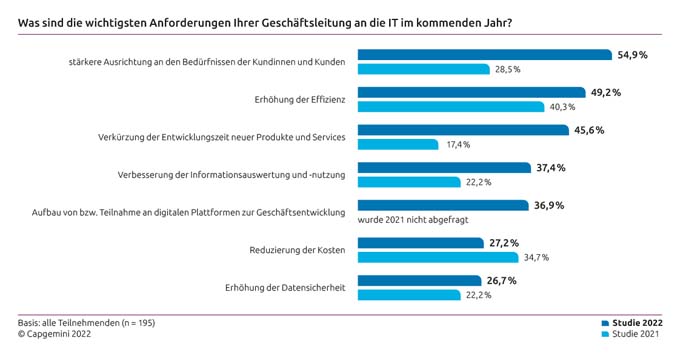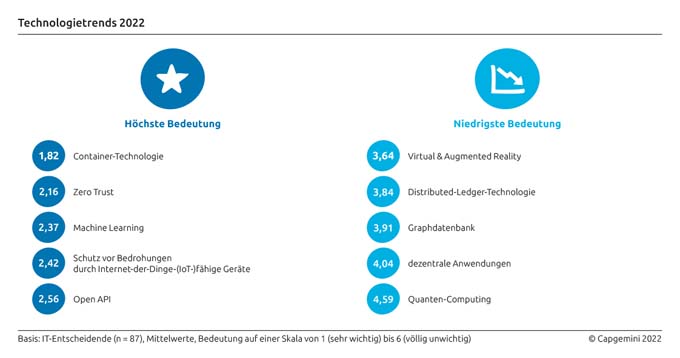IT trends 2022: customer-oriented, intelligent and climate-friendly
The most important goal of business and government for this year is to focus on the needs of their customers. This is shown by the results of Capgemini's IT Trends 2022 study.

Companies are meeting many current challenges - such as contact restrictions or the reduction of greenhouse gas emissions - with digital and, increasingly, smart technologies. These are the findings of Capgemini's IT Trends 2022 study. For this study, 195 business and IT managers from companies and public authorities in Germany, Austria and Switzerland were surveyed in September and October last year.
IT Trends 2022 study shows: Public authorities with pent-up demand
Greater alignment with customer needs is one of the three most important goals for more than half of those surveyed this year (54.9 percent). This applies even more frequently in public administration than in companies. However, public authorities have some catching up to do in many areas compared with the business community: while more than half of companies have digitized their ordering and payment processes, use customer journey analytics or base decisions on analytics findings, the figure for public authorities is only between 20 and 30 percent in each case. When it comes to building automated service offerings, business and government are roughly on par. "Companies have seen during the pandemic how important the user-friendliness of digital contact channels is for their competitiveness. They must assume that digital customer service will also be in high demand after the pandemic. According to the Online Access Act, public administration must have established user-friendly online services for its services by the end of 2022," comments Guido Kamann, Head of Capgemini in Switzerland.
Use of AI will continue to rise
Companies in particular frequently use intelligent technologies to implement their most important specifications, and their use has increased significantly in the last 12 months. Meanwhile, 35.5 percent of all respondents use artificial intelligence (AI) intensively or very intensively, compared to only 15.6 percent a year ago. The reasons for the increase include technological advances, but also new processes for development and operation. These have also led to a higher success rate: Last year, 30.4 percent of business AI users rated their success as high or very high; now the figure is 38.1 percent. The use of intelligent technologies will continue to rise over the next two years. Particularly large growth will come from users in recommendation systems (an increase of 142.9 percent after two years), personalization (120.5 percent), quality management (116.9 percent), supply chain optimization (109.6 percent) and day-to-day business analysis (105.6 percent).
More than 40 percent of greenhouse gas emissions savings from IT
Smart technologies are also being used to reduce greenhouse gas emissions. Almost 71 percent of companies have the goal of reducing annual emissions by 2026; on average by almost 37 percent. The vast majority also consider this value to be realistic. The public administration's targets are less ambitious: it wants to reduce annual greenhouse gas emissions by just under 28 percent by 2026. Overall, around 42.6 percent of the reductions are to be achieved with the help of IT, the greater part of them indirectly. Intelligent technologies will be used primarily to reduce energy consumption and optimize routes and means of transport.
Almost half of all data not available organization-wide
Data in sufficient quantity and quality is the basis for using intelligent technologies. On average, however, only slightly more than half of all data is available throughout the organization. The other half is subject to legal restrictions for around 63 percent of respondents and internal restrictions such as data protection or security measures for around 62 percent. As a result, it is only made available to a limited number of users. "Breaking down data silos and standardizing formats and quality is not an easy task for many reasons. After all, while great progress has been made in recent years with regard to providing and processing large amounts of data, scaling in other areas has been neglected. This includes dealing with increasingly more data sources, use cases, users and market change. We recommend that companies and public authorities think about a paradigm shift to a scalable, decentrally organized data landscape," explains Guido Kamann.
Demographic change is gradually being perceived as a problem
Over the next ten years, an average of just under 23 percent of IT employees will retire. Last year, the shortage of skilled workers caused little concern. Now, the proportion of CIOs who fear negative effects has risen by almost 16 percentage points to just under 52 percent. The biggest concerns are the loss of expertise and an additional increase in the shortage of skilled workers, which is already high. At the same time, the participating CIOs predict that the strategic importance of IT will increase significantly and that the department will grow. It will employ slightly more specialists than generalists, as well as more people of different nationalities. Work will become more complex and agile, but also more often done in the home office and by software robots. The proportion of women in management positions will increase.

Which other IT trends will become significant in 2022 and later?
Following Capgemini's TechnoVision global technology trends, 30 technologies and methodologies were selected to measure their importance to organizations. This year, study participants assigned the highest importance to container technologies, the Zero Trust security concept, machine learning, protection against threats from Internet of Things (IoT)-enabled devices, and Open APIs. At the other end of the scale are virtual & augmented reality, distributed ledger technology, graph databases, decentralized applications and quantum computing. They currently assign the least importance to these technologies.
Mobile wallets for payment, ticketing and access control, natural language processing, AIOps, robotic process automation with intelligent decisions, virtual & augmented reality, and event stream processing have become particularly important. This year, a particularly large number of projects are planned in the areas of machine learning, robotic process automation with intelligent decisions, preventive and predictive maintenance, open APIs, low-code app platforms, and zero trust.
Source: Capgemini









